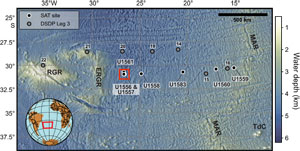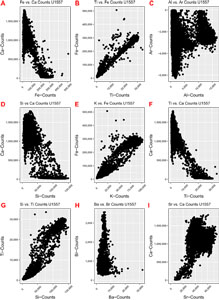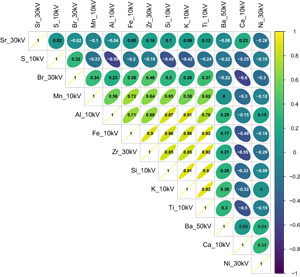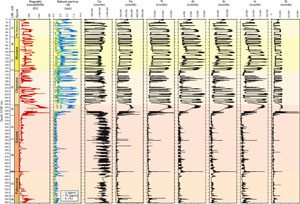Coggon, R.M., Teagle, D.A.H., Sylvan, J.B., Reece, J., Estes, E.R., Williams, T.J., Christeson, G.L., and the Expedition 390/393 Scientists
Proceedings of the International Ocean Discovery Program Volume 390/393
publications.iodp.org
https://doi.org/10.14379/iodp.proc.390393.201.2024
Data report: X-ray fluorescence scanning of sediment cores, IODP Expedition 390/393 Site U1557, South Atlantic Transect1
Christopher M. Lowery,2 Chiara Amadori,2 Chiara Borrelli,2 Gail Christeson,2 Emily Estes,2 Laura Guertin,2 Jennifer Hertzberg,3 Michael R. Kaplan,2 Ravi Kiran Koorapati,4 Adriane R. Lam,2 Andrew McIntyre,2 Julia Reece,2 Claudio Robustelli Test,2 Claire M. Routledge,2 Patricia Standring,5 Jason B. Sylvan,2 Mary Thompson,6 Alexandra Villa,2 Yi Wang,2 Shu Ying Wee,2 Trevor Williams,2 Jesse Yeon,6 Damon A.H. Teagle,2 Rosalind M. Coggon,2 and the Expedition 390/393 Scientists2
1 Lowery, C.M., Amadori, C., Borrelli, C., Christeson, G., Estes, E., Guertin, L., Hertzberg, J., Kaplan, M.R., Koorapati, R.K., Lam, A.R., McIntyre, A., Reece, J., Robustelli Test, C., Routledge, C.M., Standring, P., Sylvan, J.B., Thompson, M., Villa, A., Wang, Y., Wee, S.Y., Williams, T., Yeon, J., Teagle, D.A.H., Coggon, R.M., and the Expedition 390/393 Scientists, 2024. Data report: X-ray fluorescence scanning of sediment cores, IODP Expedition 390/393 Site U1557, South Atlantic Transect. In Coggon, R.M., Teagle, D.A.H., Sylvan, J.B., Reece, J., Estes, E.R., Williams, T.J., Christeson, G.L., and the Expedition 390/393 Scientists, South Atlantic Transect. Proceedings of the International Ocean Discovery Program, 390/393: College Station, TX (International Ocean Discovery Program). https://doi.org/10.14379/iodp.proc.390393.201.2024
2 Expedition 390/393 Scientists’ affiliations. Correspondence author: cmlowery@utexas.edu
3 International Ocean Discovery Program, Texas A&M University, USA.
4 Binghamton University, United States.
5 University of Texas at Austin, United States.
6 Texas A&M University, United States.
Abstract
Site U1557 is the deepest and one of the oldest sites drilled during International Ocean Discovery Program Expeditions 390C, 395E, 390, and 393 on the South Atlantic Transect. It differs from the nearby Site U1556, which also sits on early Paleocene crust, by its stratigraphically expanded Paleocene–Eocene section. Here, we present the results of programmatic X-ray fluorescence (XRF) core scanning of the entire thickness of the sedimentary section at Site U1557. We find a major shift in XRF geochemistry at the boundary between Lithologic Units I and II, coincident with a shift in spectral gamma ray and magnetic susceptibility, as well as a shift from alternating pelagic carbonate and pelagic clay in Unit I to pelagic carbonate in Unit II. Within Unit I, shifts in major elemental composition of core material track alternations between carbonate-rich and clay-rich intervals.
1. Introduction
The western South Atlantic Ocean has seen no drilling on oceanic crust since the heady days of Deep Sea Drilling Project (DSDP) Leg 3 and no scientific drilling at all since the 1983 retirement of GLOMAR Challenger at the end of DSDP. New drilling along the South Atlantic Transect (SAT), carried out in 2020–2022 during International Ocean Discovery Program (IODP) Expeditions 390C, 395E, 390, and 393, is thus an exciting opportunity to address fundamental questions about ocean circulation and pelagic ecosystems in this region with continuous core recovery and modern analytical techniques. In particular, these sediments provide the opportunity to reconstruct paleoceanographic changes related to a number of key topics, including the history of the deep western boundary current and the relative contributions of northern and southern component water masses during the global reorganization of ocean currents leading up to the Eocene–Oligocene transition (EOT); carbonate chemistry changes and shifts in depth of the western Atlantic carbonate compensation depth; and the Cenozoic history of the South Atlantic subtropical gyre and associated surface currents, as well as how those currents drive the productivity and structure of plankton ecosystems.
Site U1557 is located at the western end of the SAT at 30.9411˚S, 26.6298˚W at 5012 meters below sea level (mbsl) (Figure F1). It was occupied during Expeditions 390C, 395E, and 390 (Coggon et al., 2022), and the sole sediment hole was drilled during Expedition 390C (Estes et al., 2021). It is the longest sediment record of the SAT, and along with Sites U1556 and U1561, it sits on the oldest crust drilled for that project. Despite sitting on oceanic crust of roughly the same age, the sedimentary succession at Site U1557 is roughly twice as thick as nearby Site U1556, located 6.7 km west. This is because Site U1557 sits in a downthrown fault-bounded basin, whereas Site U1556 sits on an adjacent crustal high.
Hole U1557B recovered a Holocene to middle Paleocene sequence of pelagic carbonates and clays and encountered the basement at 564.8 meters below seafloor (mbsf). Sediments are divided into two main lithologic units (Coggon et al., 2022). Unit I is ~ 290 m thick and comprises alternating silty clays and nannofossil ooze of Holocene to late Eocene age. Unit II is ~275 m thick and is composed of nannofossil chalks of Eocene to Paleocene age. These two units are separated by a ~25 m thick dark brown silty clay (logged as Unit IE) that biostratigraphy indicates was deposited across the EOT. A red pelagic claystone in the middle of Unit II is interpreted to represent the Paleocene/Eocene Thermal Maximum (PETM) based on the presence of PETM excursion nannofossil taxon Rhomboaster (Coggon et al., 2024b).
X-ray fluorescence (XRF) core scanning at Site U1557 (and across all sites of the SAT) was carried out to generate a data set of elements often used for paleoceanographic interpretation (e.g., Croudace and Rothwell, 2015) to better characterize differences between sedimentary units and identify trends through time. The sampling interval was planned to produce a medium-resolution record of the entire sedimentary section, with nested segments of higher resolution scanning across key intervals of interest. At Site U1557, these include the PETM and the Eocene, particularly possible early Eocene hyperthermals. This data report contains all quality controlled XRF data produced during programmatic scanning of Site U1557 core, including basic counts of major elements plotted against stratigraphy. Complementary XRF data sets have been developed for all the other SAT sites as follows: Site U1556 (Wang et al., 2024), Site U1558 (Villa et al., 2024), Site U1559 (Robustelli Test et al., 2024), Site U1560 (Amadori et al., 2024), Site U1561 (Routledge et al., 2024), and Site U1583 (Lam et al., 2024).
2. Methods and materials
Hole U1557B was scanned in the fall of 2021 on the fourth generation Avaatech XRF core scanner (XRF 2) at the IODP Gulf Coast Repository (GCR) in College Station, Texas (USA). Additional measurements to increase the resolution through the late Paleocene and early Eocene were collected during Expedition 390/393 programmatic scanning in the fall of 2022, utilizing both core scanners at the GCR (XRF 1 is a third generation Avaatech XRF core scanner). Each archive section half was scanned at three excitation levels to measure different elements: 10 kV (6 s count time; 0.15 mA current; no filter) for major and minor elements (including Al, Si, K, Ca, Ti, Mn, Fe, Cr, P, S, and possibly Mg), 30 kV (6 s count time; 1.24 mA current; with a thick Pd filter) for heavier major and minor elements and geologically relevant trace elements (including Ca, Ti, Mn, Fe, Ni, Sr, Rb, Zr, and Zn), and 50 kV (10 s count time; 0.75 mA current; with a Cu filter) for heavier trace elements (including Sr, Rb, Zr, and Ba). The cross-core and downcore slits were set to 12 and 10 mm, respectively. Hole U1557B is the only complete sediment hole drilled at Site U1557 (Hole U1557A consists of a single core, which missed the mudline); therefore, there is no splice and all scans were conducted on sediments from this single hole.
2.1. Core preparation
Scanning was conducted on archive section halves that were allowed to warm to room temperature prior to scanning. To ensure a fresh surface for scanning, the surface of each section half was gently scraped clean across the core (so as not to move material stratigraphically up or down) with a glass slide that was cleaned with a lint-free wipe between each use. This was particularly important in softer intervals and intervals in which mold had begun to grow on the split face of the core. Once the core had been scraped clean, a 4 µm thick Ultralene film was laid across the core to prevent contamination of the XRF detector as it moved from spot to spot down the core. This film was then carefully taped along the edges to prevent any air pockets from forming in the middle, where the XRF detector would land.
2.2. Sample selection
With the exception of Cores 390C-U1557B-36X through 50X (see below), each core section was scanned at a 5 cm resolution, where the first point was 5 cm below the top of the section and the last point was as close to the bottom of the section as possible. A 3D-printed replica of the scanning window was used to examine the core at 5 cm intervals where the scan would take place. Sample spots that had a crack or an uneven surface or were characterized by drilling disturbance were skipped or moved. In sediments that were cored using the extended core barrel (XCB) system (i.e., below ~100 m core depth below seafloor, Method B [CSF-B]), biscuiting (e.g., Pearson and Thomas, 2015) was common. In these cases, care was taken to select XRF sample spots in the firm biscuits and not the soft, reworked “gravy.” In some intervals, the difference between the biscuits and the gravy could only be determined by gently probing the core through the Ultralene film. When a sample spot was found to be unsuitable for any reason, the sample spot was moved a few centimeters in either direction to maintain the target resolution when possible, or it was simply skipped if there was no suitable spot nearby.
Cores 390C-U1557B-36X through 50X (~327–464 m CSF-B) were scanned at a 2 cm resolution to capture higher frequency variations that may be associated with Eocene hyperthermal events. Sample spots were selected following the procedure described above. Biscuiting from XCB coring meant that many 2 cm scan spots had to be skipped. The fact that there is only a single complete sediment hole at Site U1557 meant that the skipped spots could not be resampled in a splice, resulting in some gaps in the high-resolution data set. This was exacerbated by cores with poor recovery. Section 50X-3 (~461 m CSF-B) contains a red pelagic claystone interpreted to represent the PETM (Coggon et al., 2024b). This section was scanned at a 1 cm resolution. Happily, there was no coring disturbance in this section, and the indurated chalk and claystone provided a smooth surface for scanning. However, some uneven surfaces around fractures in the core needed to be skipped because the scanner would not have landed on them flatly. We therefore scanned the working half to fill in these gaps (intervals where the core surface was concave in the archive half were convex in the working half and thus scannable).
2.3. Quality control
To ensure consistent data quality from the XRF core scanner, standards were run at all three excitation levels at the beginning and end of each scanning day. In the morning, 20 replicates were run at each excitation level to warm up the machine; in the evening, no replicates were run.
Raw spectral peaks were processed into peak areas and exported as count data for different elements using the Brightspec XRF spectral processing software program bAxil. To provide quality control of the data, we removed bad data points based on two criteria. First, samples with throughput values <150,000 counts/s on the 10 kV scan (indicating a gap between the sensor and the core) were deleted. Second, samples with a positive Ar value (indicating the sensor was measuring ambient air, the result of a gap between the sensor and the core) were also deleted. Typically, individual elemental values within two standard deviations of zero are also deleted from XRF data sets, but because that will vary from element to element in a single sample (e.g., Ti counts may be significant and Ni counts may not), we did not delete any samples based on this criterion but rather leave this up to the end user of the data. Quality control based on throughput and Ar values was carried out using code written for the program R (R Core Team, 2023) available on Github (https://github.com/Ravikiran2316/IODP-Exp.-390-393-XRF). Note that raw XRF data archived in the Laboratory Information Management System (LIMS) database have not been quality controlled and contain points that should be removed; quality controlled data for Site U1557 are included here as supplemental material (see XRF in Supplementary material).
3. Results
3.1. Correlation between elements
To verify that common elements associated with pelagic and detrital sources (e.g., Croudace and Rothwell, 2015) correlate with one another at Site U1557, we plotted them against each other (Figure F2). The lack of correlation between Al and Ar (Figure F2C) indicates the effectiveness of our quality control process because Al counts can be biased by ambient air, which is also rich in Ar. We find the expected positive correlation between terrigenous elements like Fe and Ti, Fe and K, and Ti and Si. Likewise, we find negative correlations between pelagic- and terrigenous-sourced elements like Ca and Fe, Ca and Ti, and Ca and Si. Noise in the crossplot data is likely at least partially the result of the highly variable sedimentology of this deep hole.
To determine which elements correlate with each other, we conducted a Spearman’s rank correlation (Figure F3). Spearman’s correlation does not assume a normal distribution of the data set, and our raw elemental counts lack a normal distribution. The strength of the relationship between element pairs was quantified with Spearman’s rank correlation coefficient (ρ). The strongest correlations (ρ > 0.85) are all positive correlations among the terrigenous-sourced elements Al, Fe, Zr, Si, and K. The weakest correlations are between Sr and Ni against most elements.
3.2. Stratigraphic trends
Select elements (Ca, Fe, Ti, Al, Si, K, and Zr) were plotted stratigraphically alongside shipboard magnetic susceptibility and spectral gamma ray data from whole-round core scanning (Coggon et al., 2024a) and sedimentary units (Coggon et al., 2024b) to compare stratigraphic trends in XRF data with standard shipboard measurements (Figure F4). Geologic epochs, defined by the shipboard age model (Coggon et al., 2024b), are included along the y-axis.
There is a major first-order shift in XRF data alongside the shift in physical properties defined by the boundary between Lithologic Units I and II. Unit I consists of alternating nannofossil ooze and pelagic clay, and Unit II comprises carbonate-rich nannofossil and foraminiferal ooze and chalk ( Coggon et al., 2024b). The sharp lithologic variations that characterize Unit I are distinct in the XRF data,. with clay-rich intervals defined by peaks of terrigenous-sourced elements like Fe, Ti, Al, Si, K, and Zr and carbonate-rich intervals defined by peaks in Ca. A similar variability may appear to occur in Unit II (particularly in Ca counts), but this is an artifact of core gaps between intervals of variable but consistently high Ca counts. Several apparent outliers occur in XRF values in the Eocene and Paleocene intervals that were not removed by our quality control process. The largest of these, at the Paleocene/Eocene boundary, represents the red clay of the PETM; the others may represent hyperthermals.
4. Data availability
XRF data at all three excitation levels are included here in Supplementary material and are permanently archived at PANGAEA (https://Pangea.de). The code used to conduct quality control can be found on Github (https://github.com/Ravikiran2316/IODP-Exp.-390-393-XRF).
5. Acknowledgments
XRF scans reported here comprised the programmatic scanning for IODP Expeditions 390C, 390, and 393 and were funded by the National Science Foundation (NSF) in agreement with the US Science Support Program (USSSP). We also acknowledge XRF scanning travel support for US scientists administered by USSSP and support of E.R. Estes and T.J. Williams through NSF award OCE1326927. We are grateful for the technicians and crew of JOIDES Resolution, without whom we would not have any cores to scan. We are also grateful to the staff of the GCR, especially Michelle Penkrot. We thank reviewer Matthew Jones for his constructive feedback that strengthened the presentation of this dataset.
References
Amadori, C., Borrelli, C., Christeson, G., Estes, E., Guertin, L., Hertzberg, J., Kaplan, M.R., Koorapati, R.K., Lam, A.R., Lowery, C.M., McIntyre, A., Reece, J., Robustelli Test, C., Routledge, C.M., Standring, P., Sylvan, J.B., Thompson, M., Villa, A., Wang, Y., Wee, S.Y., Williams, T., Yeon, J., Teagle, D.A.H., Coggon, R.M., and the Expedition 390/393 Scientists, 2024. Data report: X-ray fluorescence scanning of sediment cores, IODP Expedition 390/393 Site U1560, South Atlantic Transect. In Coggon, R.M., Teagle, D.A.H., Sylvan, J.B., Reece, J., Estes, E.R., Williams, T.J., Christeson, G.L., and the Expedition 390/393 Scientists, South Atlantic Transect. Proceedings of the International Ocean Discovery Program, 390/393: College Station, TX (International Ocean Discovery Program). https://doi.org/10.14379/iodp.proc.390393.205.2024
Coggon, R.M., Sylvan, J.B., Teagle, D.A.H., Reece J., Christeson, G.L., Estes, E.R., Williams, T.J., and the Expedition 390 Scientists, 2022. Expedition 390 Preliminary Report: South Atlantic Transect 1. International Ocean Discovery Program. https://doi.org/10.14379/iodp.pr.390.2022
Coggon, R.M., Sylvan, J.B., Estes, E.R., Teagle, D.A.H., Reece, J., Williams, T.J., Christeson, G.L., Aizawa, M., Borrelli, C., Bridges, J.D., Carter, E.J., Dinarès-Turell, J., Estep, J.D., Gilhooly, W.P., III, Grant, L.C.J., Kaplan, M.R., Kempton, P.D., Lowery, C.M., McIntyre, A., Routledge, C.M., Slagle, A.L., Takada, M., Tamborrino, L., Wang, Y., Yang, K., Albers, E., Amadori, C., Belgrano, T.M., D’Angelo, T., Doi, N., Evans, A., Guérin, G.M., Harris, M., Hojnacki, V.M., Hong, G., Jin, X., Jonnalagadda, M., Kuwano, D., Labonte, J.M., Lam, A.R., Latas, M., Lu, W., Moal-Darrigade, P., Pekar, S.F., Robustelli Test, C., Ryan, J.G., Santiago Ramos, D., Shchepetkina, A., Villa, A., Wee, S.Y., Widlansky, S.J., Kurz, W., Prakasam, M., Tian, L., Yu, T., and Zhang, G., 2024a. Site U1561. In Coggon, R.M., Teagle, D.A.H., Sylvan, J.B., Reece, J., Estes, E.R., Williams, T.J., Christeson, G.L., and the Expedition 390/393 Scientists, South Atlantic Transect. Proceedings of the International Ocean Discovery Program, 390/393: College Station, TX (International Ocean Discovery Program). https://doi.org/10.14379/iodp.proc.390393.104.2024
Coggon, R.M., Teagle, D.A.H., Sylvan, J.B., Reece, J., Estes, E.R., Williams, T.J., Christeson, G.L., Aizawa, M., Albers, E., Amadori, C., Belgrano, T.M., Borrelli, C., Bridges, J.D., Carter, E.J., D’Angelo, T., Dinarès-Turell, J., Doi, N., Estep, J.D., Evans, A., Gilhooly, W.P., III, Grant, L.C.J., Guérin, G.M., Harris, M., Hojnacki, V.M., Hong, G., Jin, X., Jonnalagadda, M., Kaplan, M.R., Kempton, P.D., Kuwano, D., Labonte, J.M., Lam, A.R., Latas, M., Lowery, C.M., Lu, W., McIntyre, A., Moal-Darrigade, P., Pekar, S.F., Robustelli Test, C., Routledge, C.M., Ryan, J.G., Santiago Ramos, D., Shchepetkina, A., Slagle, A.L., Takada, M., Tamborrino, L., Villa, A., Wang, Y., Wee, S.Y., Widlansky, S.J., Yang, K., Kurz, W., Prakasam, M., Tian, L., Yu, T., and Zhang, G., 2024b. Expedition 390/393 methods. In Coggon, R.M., Teagle, D.A.H., Sylvan, J.B., Reece, J., Estes, E.R., Williams, T.J., Christeson, G.L., and the Expedition 390/393 Scientists, South Atlantic Transect. Proceedings of the International Ocean Discovery Program, 390/393: College Station, TX (International Ocean Discovery Program). https://doi.org/10.14379/iodp.proc.390393.102.2024
Croudace, I.W., and Rothwell, R.G., 2015. Micro-XRF Studies of Sediment Cores: Applications of a non-destructive tool for the environmental sciences: (Springer Dordrecht). https://doi.org/10.1007/978-94-017-9849-5
Estes, E.R., Williams, T., Midgley, S., Coggon, R.M., Sylvan, J.B.,Christeson, G.L., Teagle, D.A.H., and the Expedition 390C Scientists, 2021. Expedition 390C Preliminary Report: South Atlantic Transect Reentry Systems. International Ocean Discovery Program. https://doi.org/10.14379/iodp.pr.390C.2021
Lam, A.R., Amadori, C., Borrelli, C., Christeson, G., Estes, E., Guertin, L., Hertzberg, J., Kaplan, M.R., Koorapati, R.K., Lowery, C.M., McIntyre, A., Reece, J.S., Robustelli Test, C., Routledge, C.M., Standring, P., Sylvan, J.B., Thompson, M., Villa, A., Wang, Y., Wee, S.Y., Williams, T., Yeon, J., Teagle, D.A.H., Coggon, R.M., and the Expedition 390/393 Scientists, 2024. Data report: X-ray fluorescence scanning of sediment cores, IODP Expedition 390/393 Site U1583, South Atlantic Transect. In Coggon, R.M., Teagle, D.A.H., Sylvan, J.B., Reece, J., Estes, E.R., Williams, T.J., Christeson, G.L., and the Expedition 390/393 Scientists, South Atlantic Transect. Proceedings of the International Ocean Discovery Program, 390/393: College Station, TX (International Ocean Discovery Program). https://doi.org/10.14379/iodp.proc.390393.202.2024
Lowery, C.M., Amadori, C., Borrelli, C., Christeson, G., Estes, E., Guertin, L., Hertzberg, J., Kaplan, M.R., Koorapati, R.K., Lam, A.R., McIntyre, A., Reece, J., Robustelli Test, C., Routledge, C.M., Standring, P., Sylvan, J.B., Thompson, M., Villa, A., Wang, Y., Wee, S.Y., Williams, T., Yeon, J., Teagle, D.A.H., Coggon, R.M., and the Expedition 390/393 Scientists, 2024. Supplementary material, h ttps://doi.org/10.14379/iodp.proc.390393.201supp.2024 . In Lowery, C.M., Amadori, C., Borrelli, C., Christeson, G., Estes, E., Guertin, L., Hertzberg, J., Kaplan, M.R., Koorapati, R.K., Lam, A.R., McIntyre, A., Reece, J., Robustelli Test, C., Routledge, C.M., Standring, P., Sylvan, J.B., Thompson, M., Villa, A., Wang, Y., Wee, S.Y., Williams, T., Yeon, J., Teagle, D.A.H., Coggon, R.M., and the Expedition 390/393 Scientists, Data report: X-ray fluorescence scanning of sediment cores, IODP Expedition 390/393 Site U1557, South Atlantic Transect. In Coggon, R.M., Teagle, D.A.H., Sylvan, J.B., Reece, J., Estes, E.R., Williams, T.J., Christeson, G.L., and the Expedition 390/393 Scientists, South Atlantic Transect. Proceedings of the International Ocean Discovery Program, 390/393: College Station, TX (International Ocean Discovery Program).
Pearson, P.N., and Thomas, E., 2015. Drilling disturbance and constraints on the onset of the Paleocene–Eocene boundary carbon isotope excursion in New Jersey. Climate of the Past, 11(1):95–104. https://doi.org/10.5194/cp-11-95-2015
R Core Team, 2023. R: A language and environment for statistical computing. R Foundation for Statistical Computing. https://www.r-project.org/
Robustelli Test, C., Amadori, C., Borrelli, C., Christeson, G., Estes, E., Guertin, L., Hertzberg, J., Kaplan, M.R., Koorapati, R.K., Lam, A.R., Lowery, C.M., McIntyre, A., Reece, J., Routledge, C.M., Standring, P., Sylvan, J.B., Thompson, M., Villa, A., Wang, Y., Wee, S.Y., Williams, T., Yeon, J., Teagle, D.A.H., Coggon, R.M., and the Expedition 390/393 Scientists, 2024. Data report: X-ray fluorescence scanning of sediment cores, IODP Expedition 390/393 Site U1559, South Atlantic Transect. In Coggon, R.M., Teagle, D.A.H., Sylvan, J.B., Reece, J., Estes, E.R., Williams, T.J., Christeson, G.L., and the Expedition 390/393 Scientists, South Atlantic Transect. Proceedings of the International Ocean Discovery Program, 390/393: College Station, TX (International Ocean Discovery Program). https://doi.org/10.14379/iodp.proc.390393.204.2024
Routledge, C.M., Amadori, C., Borrelli, C., Christeson, G., Estes, E., Guertin, L., Hertzberg, J., Kaplan, M.R., Koorapati, R.K., Lam, A.R., Lowery, C.M., McIntyre, A., Reece, J., Robustelli Test, C., Standring, P., Sylvan, J.B., Thompson, M., Villa, A., Wang, Y., Wee, S.Y., Williams, T., Yeon, J., Teagle, D.A.H., Coggon, R.M., and the Expedition 390/393 Scientists, 2024. Data report: X-ray fluorescence scanning of sediment cores, IODP Expedition 390/393 Site U1561, South Atlantic Transect. In Coggon, R.M., Teagle, D.A.H., Sylvan, J.B., Reece, J., Estes, E.R., Williams, T.J., Christeson, G.L., and the Expedition 390/393 Scientists, South Atlantic Transect. Proceedings of the International Ocean Discovery Program, 390/393: College Station, TX (International Ocean Discovery Program). https://doi.org/10.14379/iodp.proc.390393.207.2024
Teagle, D.A.H., Reece, J., Coggon, R.M., Sylvan, J.B., Christeson, G.L., Williams, T.J., Estes, E.R., and the Expedition 393 Scientists, 2023. Expedition 393 Preliminary Report: South Atlantic Transect 2. International Ocean Discovery Program. https://doi.org/10.14379/iodp.pr.393.2023
Villa, A., Amadori, C., Borrelli, C., Christeson, G., Estes, E., Guertin, L., Hertzberg, J., Kaplan, M.R., Koorapati, R.K., Lam, A.R., Lowery, C.M., McIntyre, A., Reece, J., Robustelli Test, C., Routledge, C.M., Standring, P., Sylvan, J.B., Thompson, M., Wang, Y., Wee, S.Y., Williams, T., Yeon, J., Teagle, D.A.H., Coggon, R.M., and the Expedition 390/393 Scientists, 2024. Data report: X-ray fluorescence scanning of sediment cores, IODP Expedition 390/393 Site U1558, South Atlantic Transect. In Coggon, R.M., Teagle, D.A.H., Sylvan, J.B., Reece, J., Estes, E.R., Williams, T.J., Christeson, G.L., and the Expedition 390/393 Scientists, South Atlantic Transect. Proceedings of the International Ocean Discovery Program, 390/393: College Station, TX (International Ocean Discovery Program). https://doi.org/10.14379/iodp.proc.390393.203.2024
Wang, Y., Amadori, C., Borrelli, C., Christeson, G., Estes, E., Guertin, L., Hertzberg, J., Kaplan, M.R., Koorapati, R.K., Lam, A.R., Lowery, C.M., McIntyre, A., Reece, J., Robustelli Test, C., Routledge, C.M., Standring, P., Sylvan, J.B., Thompson, M., Villa, A., Wee, S.Y., Williams, T., Yeon, J., and the Expedition 390/393 Scientists, 2024. Data report: X-ray fluorescence scanning of sediment cores, IODP Expedition 390/393 Site U1556, South Atlantic Transect. In Coggon, R.M., Teagle, D.A.H., Sylvan, J.B., Reece, J., Estes, E.R., Williams, T.J., Christeson, G.L., and the Expedition 390/393 Scientists, South Atlantic Transect. Proceedings of the International Ocean Discovery Program, 390/393: College Station, TX (International Ocean Discovery Program). https://doi.org/10.14379/iodp.proc.390393.206.2024



